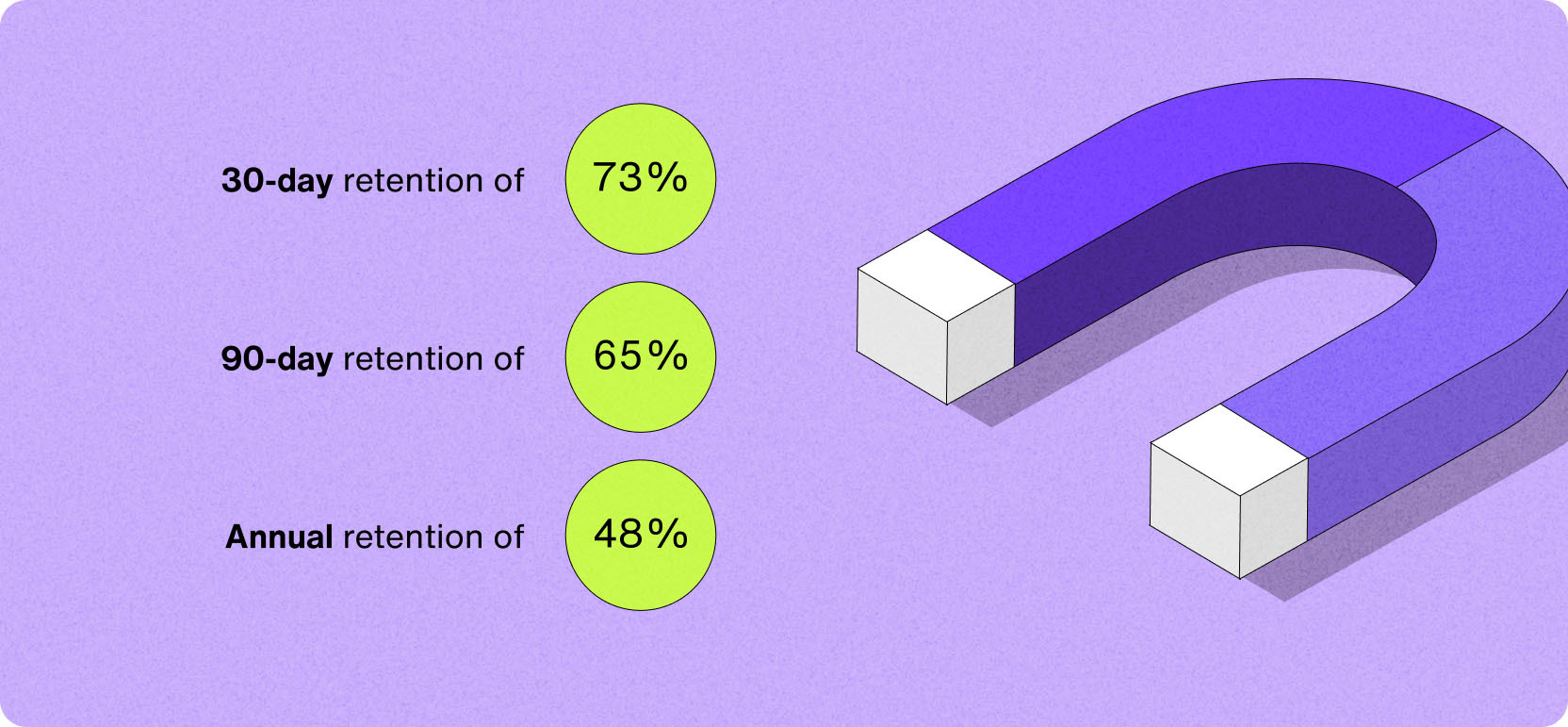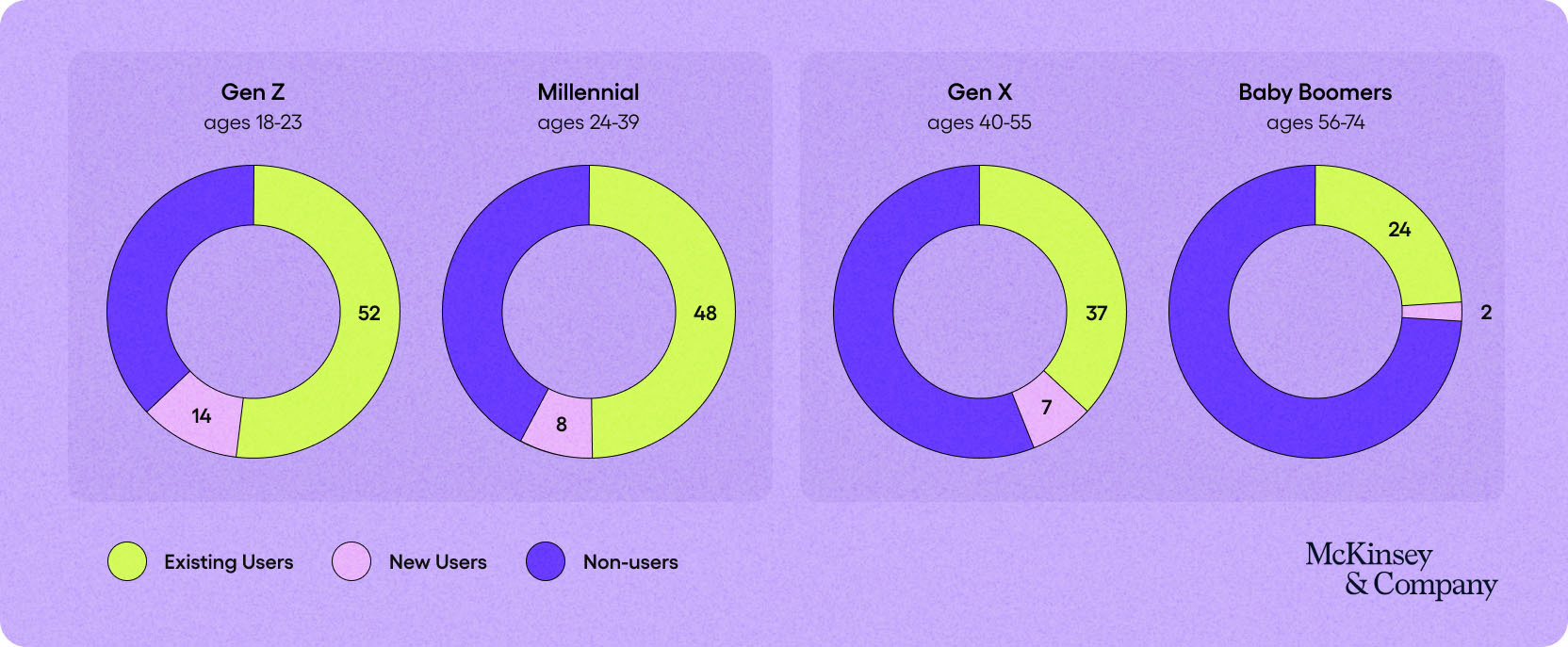What every fintech app must know about retention

The 2023 edition of AppsFlyer’s App uninstall report found that on average, nearly half of all apps are uninstalled a mere 30 days after download.
Yikes.
This fact shows why businesses that rely on mobile applications must focus less on the endless loop of acquiring and losing new users and more on consistently retaining their existing users.
In 2023 and beyond, retention will be one of the leading factors in long-term success for app-based brands.
In this article, we’ll focus on how apps with a financial focal point should think about retention, why it matters, and how business leaders can improve their mobile app retention rates.
Retention review: What is app user retention?
If you’re anything like us, you always have dozens of business metrics in your brain.
So let’s do a quick refresher on the topic before diving into the tactics.
In a nutshell, app user retention describes the percentage of people who regularly use your app over whatever period you decide to measure. For apps, retention is often measured in 30 day, 90 day, and one-year increments.
Retention rates provide insight into another crucial mobile metric: churn. Churn is the inverse of retention. A 30% app retention rate signifies a 70% churn rate.
We’ll get into some actual numbers shortly. Still, the overarching point is that higher retention and lower churn are the typical goals and indicate user happiness with your application and your overall business.
Stickiness vs. retention
Stickiness and retention are often referred to interchangeably. And that’s not a huge deal, but since we’re diving into the details here, we’ll quickly mention how they differ.
Stickiness refers to people making repeat purchases. Retention is more wide-reaching and references loyal customers who stay with your brand and interact with your app for a measurable time.
Stickiness is often seen as a precursor to retention, and the end goal of developing stickiness is to generate long-lasting retention.
Why does retention matter?
What if you could boost your waning ROI on app user acquisition, position yourself perfectly for flawless upsells and referrals, and know once and for all that you’re delivering what your ideal audience segment is looking for?
With a focus on app retention, you can.
Inform product-market fit
Today, markets shift quickly as consumers follow new trends and competitors arrive. If you’re having trouble understanding whether your product still serves your target market, retention rates will tell you.
When consumers gladly return to your application despite there very likely being other businesses and platforms in your space — AKA when they retain — you can be assured the product you’re providing perfectly fits its intended market.
Chances for expansion + referrals
If your app is free to use — which many are today — then your best chance for generating income from users comes later in the customer journey.
When users find enough value in your app to keep coming back for more, you’ll have the chance to sell them on paid features or an upgraded, paid user plan. At this point, you can also start asking for referrals and recommendations, which tend to generate more trust and action from new consumers than any advertisement ever could.
Better ROI than acquisition activities
The hard truth is that marketing is getting so much more difficult. Digital-savvy competition has become the norm, and marketing expenses are rising along with this new era of businesses willing to pay them.
Due to all of the above, customer acquisition costs have been steadily creeping up for years.
Retaining the folks you already have used your application has proven ROI and is one of the best ways to reduce spending on new customer acquisition.
What is the retention rate of fintech apps?
Fintech, an amalgamation of finance and technology, is a modern term for technology that delivers financial services digitally.
Fintech has become a pretty broad term describing apps and software that aid users in online banking, investing, payment processing, fundraising, and beyond.
The good news is that finance-related apps often have decent retention rates.
Fintech applications most likely see lower turnover compared to other categories simply because it's a little more difficult, and risky, for individuals to hop between banks and other financial institutions than, say task management tools.
The 2022 Mobile App Customer Engagement Report from Alchemer found that apps in the fintech category had 30-day retention of 73%, 90-day retention of 65%, and annual retention of 48%.

If you find yourself hitting that benchmark, congrats — you’re clearly doing many things right. And if you aren’t there yet, the beauty of apps is that you can customize them endlessly to create an experience that engenders sky-high user retention.
Whatever boat you’re in, we’ll get into core tactics for building retention right after this interesting aside addressing one of the most important segments for fintech app businesses today.
Highlight: The rise of young fintech app users
Interestingly, but perhaps not all that surprisingly, Gen Z and Millennials use fintech apps much more heavily than Gen X and Baby Boomers.

How do you appeal to this group of users?
You tailor your app to the things they care about. A PWC report determined that Gen Z in particular, cares more than the general population about design, brand personality, and of course, the mobile experience.
And don’t worry, focusing on these elements certainly won’t alienate the rest of your market. The same report found that over 70% of consumers say user experience is core to their purchasing decisions — and that they’d even pay more if it meant they’d get a better experience.
Pay more, you say?
It sounds like it’s time to plunge into how to update your app to develop even more devoted fans.
Four tips for fintech app retention
Finally, let's explore a handful of achievable tactics legacy finance firms and new entrants alike can deploy to create a fintech app that delivers loyalty-inspiring personality and experience for users of all ages.
1. Follow the data
First, we do what we can to get a step ahead of the issue.
There’s one seemingly magical source for getting to know how users feel about the in-app experience and how likely they are to uninstall: your app’s data.
While you’re probably already tracking some KPIs within your app, here are a few more we recommend specifically for measuring retention:
Average number of sessions per user, in a specific period
Time spent per session over time
Time per session
Session interval
By tracking robust data around user sessions, you’ll be able to comprehend the app experience from a user POV, and what kinds of numbers predicate user uninstalls. And that puts you in a unique position to deploy and test new tactics to build retention.
2. Personalize your push notifications
Speaking of app user data, personalized notifications are also core to yet another retention tactic.
Personalized notifications from your app leverage customer info to target the appropriate user with the best offer or recommendation at the perfect time — increasing the chances of not only an in-the-moment conversion but of loyal customers who enjoy the fact that you care enough to make your offers relevant.
For example, Moven is a fintech platform that combines customer data and personalized notifications to help financial apps remind their users to save money exactly when they’re most likely to take that action. As a result, folks who receive these messages are actually more likely to set aside money — a win for both the customer and the financial institution.
3. Stir up some conversation
Conversational banking is the process of delivering banking services via, well, conversational methods. These can include voice and video calling, texting, online messaging, on-site or in-app chat, and even voice assistants like Siri and Alexa.
What conversational banking — or conversational finance if we’re talking about services from other financial organizations — does is enable customers to interact with their institutions of choice in the channels and at the times that work for them. In other words, it creates a more modern and retention-worthy customer experience.
While creating the software around this kind of cutting-edge experience would have been prohibitively pricey a decade ago, today Sendbird exists to deliver a robust in-app messaging experience for financial services that’s affordable and approachable for developers to install.
Just look at Paytm, a leading financial services firm in India that does billions in transactions every year. When they settled on introducing in-platform chat as a way to boost user engagement and satisfaction, they realized they were looking at a massive effort from compliance to moderation to integration. So they chose Sendbird, the leading communications API platform, to facilitate chat instead of building it from scratch, which comes ready with all the features and support they needed to get to market quickly.
To date, the Sendbird Platform API has supported Paytm users in sending more than one billion messages.
4. Add a social element
Social+ is a new business model in which community is given the same weight as actual tech functionality because, for some modern businesses, community is just as crucial to overall success.
A social+ strategy can even be applied to create personalized banking and fintech experiences that engender retention.
Take Public.com for example. This platform for stock trading is a prime illustration of the social+ movement. The tool boasts a community of millions of investor and analyst users, which customers can tap into to make the most educated selections while trading stocks.
Move toward going social+ with easy-to-install software that powers 1:1, group, and even large-scale user conversations to make your app super engaging.
Intrigued with how your business can apply communication capabilities to boost engagement, conversions, satisfaction, and of course, retention?
Then don’t waste any time getting started by signing up with Sendbird for a free trial or developer plan.










